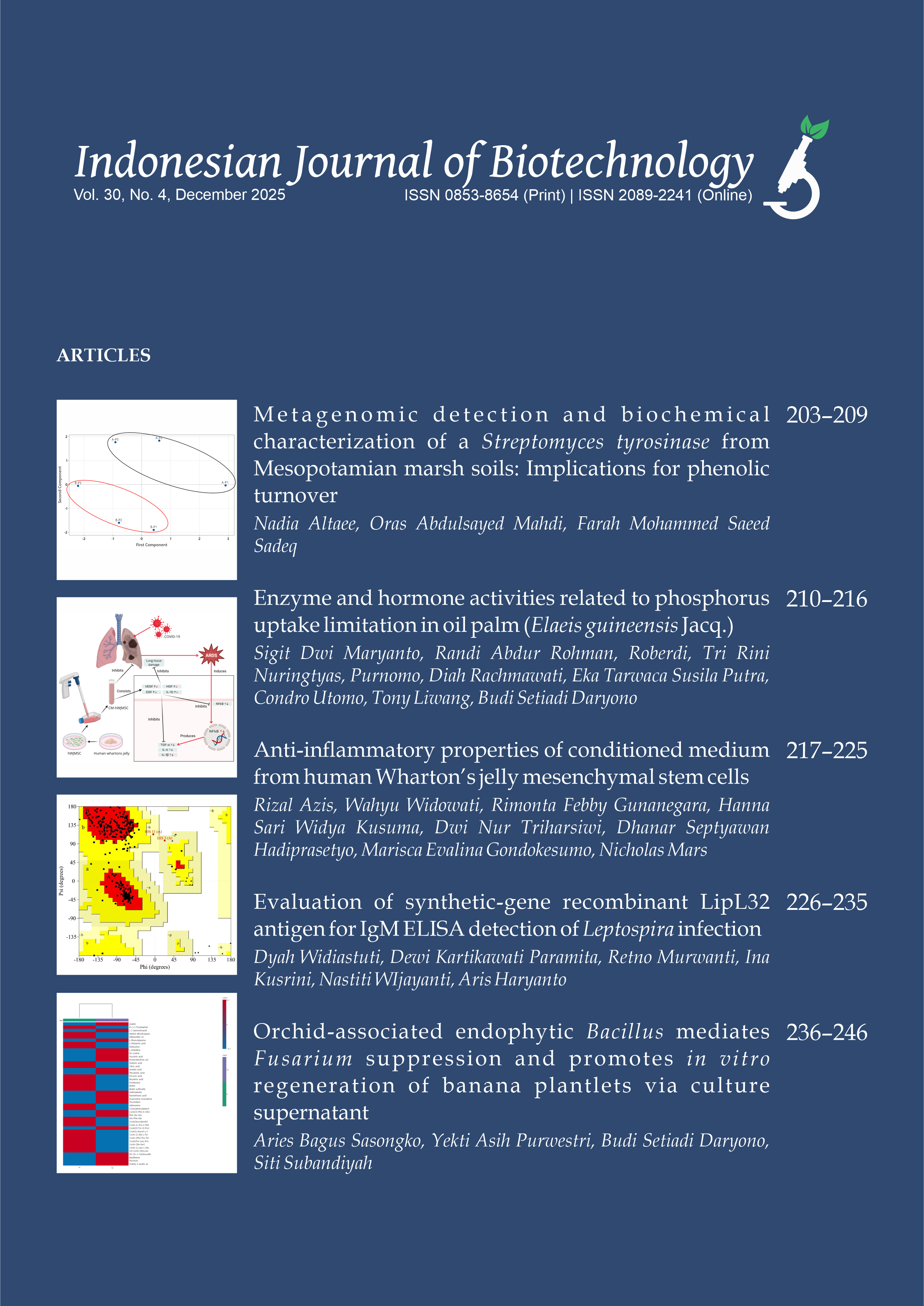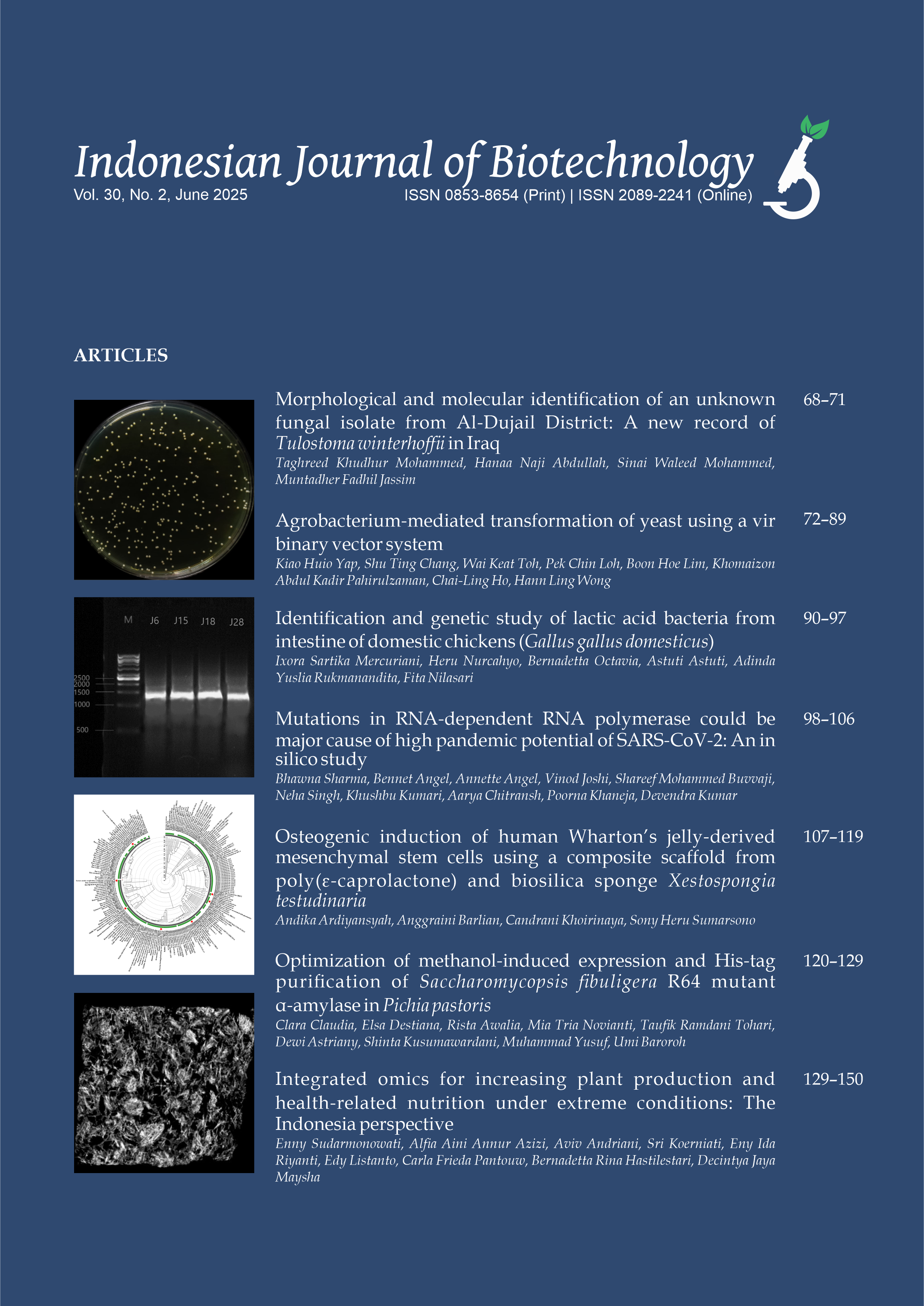A simple method of plant sectioning using the agarose embedding technique for screening intracellular green fluorescent protein
Nisa Ihsani(1*), Fenny Martha Dwivany(2), Sony Suhandono(3)
(1) Department of Biotechnology, Faculty of Science and Technology, Universitas Muhammadiyah Bandung. Soekarno‐Hatta Street No.752 Bandung, Cipadung Kidul, Panyileukan, Bandung City, West Java 40614, Indonesia
(2) The School of Life Sciences and Technology, Institut Teknologi Bandung. Ganesa Street No.10, Bandung 40132
(3) The School of Life Sciences and Technology, Institut Teknologi Bandung. Ganesa Street No.10, Bandung 40132
(*) Corresponding Author
Abstract
It is difficult to observe plant tissue sections transformed using the agroinfiltration method under a fluorescent microscope. This is due to the softness of the post‐transformation plant. This research was conducted to optimize the sectioning of tobacco stems transformed through the agarose embedding technique. Optimization was conducted at various agarose concentrations: 2%, 4%, and 6%, followed by five minutes of incubation at various temperatures: –80 °C, 4 °C, and 25 °C. The stems were then cut using a scalpel and examined under a fluorescence microscope. The results showed that the embedding method using 6% agarose was more effective at producing a tobacco stem section than 2% or 4% agarose. Meanwhile, incubation at 25 °C was better suited to the transformed tobacco stems than at 4 °C or –80 °C. Green Fluorescent Protein (GFP) could be determined under a fluorescent microscope when using the optimum method. Thus, the optimum method for creating sections of transformed tobacco stems by embedding was to use 6% agarose followed by incubation at 25 °C for 5 min. The optimum result can be applied to obtain a slight section of tobacco stem in order to observe a recombinant protein or other anatomical structures.
Keywords
Full Text:
PDFReferences
Adibzadeh S, Fardaei M, Takhshid MA, Miri MR, Dehbidi GR, Farhadi A, Ranjbaran R, Alavi P, Nikouyan N, Seyyedi N, Naderi S, Eskandari A, BehzadBehbahani A. 2019. Enhancing stability of destabilized green fluorescent protein using chimeric mRNA containing human beta-globin 5′ and 3′ untranslated regions. Avicenna J. Med. Biotechnol. 11(1):112 – 117.
Bekheet SA, Sota V, El-Shabrawi HM, El-Minisy AM. 2020. Cryopreservation of shoot apices and callus cultures of globe artichoke using vitrification method. J. Genet. Eng. Biotechnol. 18(1):1–8. doi:10.1186/s43141-019-0016-1.
Cai H, Yao H, Li T, Hutter CA, Li Y, Tang Y, Seeger MA, Li D. 2020. An improved fluorescent tag and its nanobodies for membrane protein expression, stability assay, and purification. Commun. Biol. 3(1):753. doi:10.1038/s42003-020-01478-z.
Celler K, Fujita M, Kawamura E, Ambrose C, Herburger K, Holzinger A, Wasteneys GO. 2016. Microtubules in plant cells: Strategies and methods for immunofluorescence, transmission electron microscopy, and live cell imaging. Methods Mol. Biol. 1365:155–184. doi:10.1007/978-1-4939-3124-8_8.
Hobro AJ, Smith NI. 2017. An evaluation of fixation methods: Spatial and compositional cellular changes observed by Raman imaging. Vib. Spectrosc. 91:31– 45. doi:10.1016/j.vibspec.2016.10.012.
Hofgen R, Willmitzer L. 1988. Storage of competent cells for Agrobacterium transformation. Nucleic Acids Res. 16(20):9977. doi:10.1093/nar/16.20.9877.
Kaur H, Nguyen K, Kumar P. 2022. Pressure and temperature dependence of fluorescence anisotropy of green fluorescent protein. RSC Adv. 12(14):8647–8655. doi:10.1039/d1ra08977c.
Kitin P, Nakaba S, Hunt CG, Lim S, Funada R. 2020. Direct fluorescence imaging of lignocellulosic and suberized cell walls in roots and stems. AoB Plants 12(4):plaa032. doi:10.1093/AOBPLA/PLAA032.
Knapp E, Flores R, Scheiblin D, Modla S, Czymmek K, Yusibov V. 2012. A cryohistological protocol for preparation of large plant tissue sections for screening intracellular fluorescent protein expression. Biotechniques 52(1):31–37. doi:10.2144/000113778.
Kunkel J, Asuri P. 2014. Function, structure, and stability of enzymes confined in agarose gels. PLoS One 9(1):e86785. doi:10.1371/journal.pone.0086785.
Leckie BM, Stewart CN. 2011. Agroinfiltration as a technique for rapid assays for evaluating candidate insect resistance transgenes in plants. Plant Cell Rep. 30(3):325–334. doi:10.1007/s00299-010-0961-2.
Lestari SW, Ilato KF, Pratama MIA, Fitriyah NN, Pangestu M, Pratama G, Margiana R. 2018. Sucrose ’versus’ trehalose cryoprotectant modification in oocyte vitrification: A study of embryo development. Biomed. Pharmacol. J. 11(1):97–104. doi:10.13005/bpj/1351.
Li MW, Zhou L, Lam HM, Langowski J. 2015. Paraformaldehyde fixation may lead to misinterpretation of the subcellular localization of plant high mobility group box proteins. PLoS One 10(8):e0135033. doi:10.1371/journal.pone.0135033.
Liyanage S, Dassanayake RS, Bouyanfif A, Rajakaruna E, Ramalingam L, Moustaid-Moussa N, Abidi N. 2017. Optimization and validation of cryostat temperature conditions for trans-reflectance mode FTIR microspectroscopic imaging of biological tissues. MethodsX 4:118–127. doi:10.1016/j.mex.2017.01.006.
Moo-Young M. 2019. Comprehensive Biotechnology 3rd Edition. Elsevier Science. doi:10.1016/s0769- 2617(86)80233-7.
Pace MR. 2019. Optimal preparation of tissue sections for light-microscopic analysis of phloem anatomy. In: Liesche, J. (eds) Phloem. Methods in Molecular Biology, volume 2014. New York, NY: Humana Press. doi:10.1007/978-1-4939-9562-2_1.
Park S. 2006. Agrobacterium tumefaciens-mediated transformation of tobacco (Nicotiana tabacum L.) leaf disks: Evaluation of the co-cultivation conditions to increase Β-glucuronidase gene activity. Master’s thesis, Louisiana State University, Los Angeles.
Roqueborda CA, Kulus D, de Souza AV, Kaviani B, Vicente EF. 2021. Cryopreservation of agronomic plant germplasm using vitrificationbased methods: An overview of selected case studies. Int. J. Mol. Sci. 22(11):6157. doi:10.3390/ijms22116157.
Sokalingam S, Raghunathan G, Soundrarajan N, Lee SG. 2012. A study on the effect of surface lysine to arginine mutagenesis on protein stability and structure using green fluorescent protein. PLoS One 7(7):e40410. doi:10.1371/journal.pone.0040410.
Soonthornkalump S, Yamamoto SI, Meesawat U. 2020. Adding ascorbic acid to reduce oxidative stress during cryopreservation of somatic embryos of Paphiopedilum niveum (Rchb.f.) stein, an endangered orchid species. Hortic. J. 89(4):466–472. doi:10.2503/hortj.UTD-114.
Suhandono S, Apriyanto A, Ihsani N. 2014. Isolation and characterization of three cassava elongation factor 1 alpha (MeEF1A) promoters. PLoS One 9(1):e84692. doi:10.1371/journal.pone.0084692.
Vidot K, Gaillard C, Rivard C, Siret R, Lahaye M. 2018. Cryo-laser scanning confocal microscopy of diffusible plant compounds. Plant Methods 14(1):89. doi:10.1186/s13007-018-0356-x.
Wahyuningsih S, Lawrie MD, Daryono BS, Moeljopawiro S, Jang S, Semiarti E. 2016. Early detection of the orchid flowering gene PaFT1 in tobacco cells using a GFP reporter. Indones. J. Biotechnol. 21(1):12–21. doi:10.22146/ijbiotech.26781.
Wang X, Lai Y. 2021. Three basic types of fluorescence microscopy and recent improvement. E3S Web Conf. 290:01031. doi:10.1051/e3sconf/202129001031.
Whaley D, Damyar K, Witek RP, Mendoza A, Alexander M, Lakey JR. 2021. Cryopreservation: An overview of principles and cell-specific considerations. Cell Transplant. 30:963689721999617. doi:10.1177/0963689721999617.
Article Metrics
Refbacks
- There are currently no refbacks.
Copyright (c) 2023 The Author(s)

This work is licensed under a Creative Commons Attribution-ShareAlike 4.0 International License.









